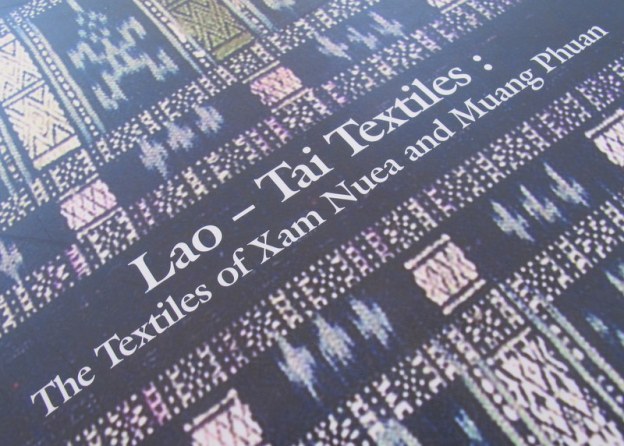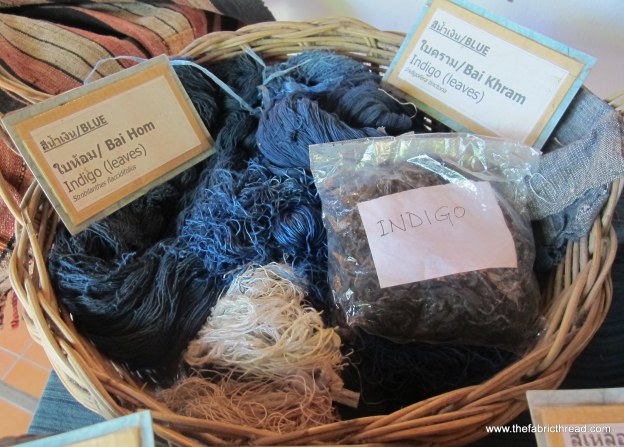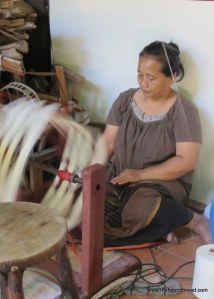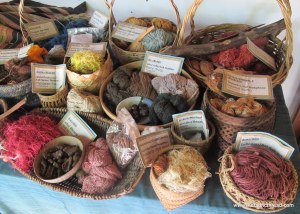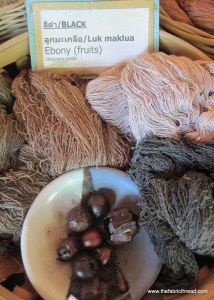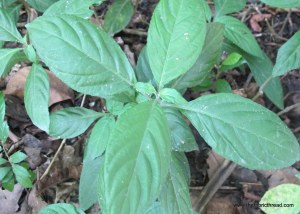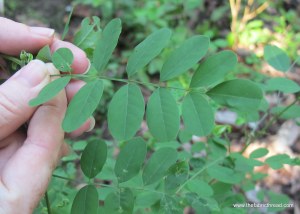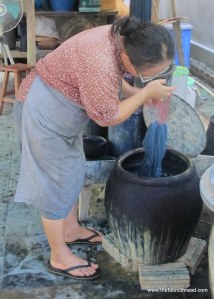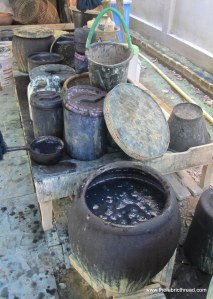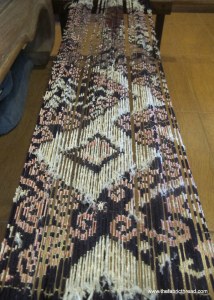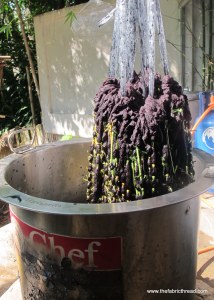LAO-TAI TEXTILES:
The Textiles of Xam Nuea and Muang Phuan by Patricia Cheesman
Published by Studio Naenna Co Ltd, Chiang Mai, Thailand.
ISBN: 974-272-915-8
AUTHOR:
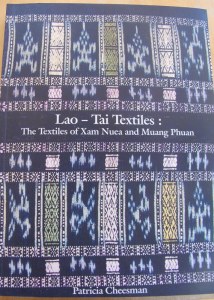 Patricia Cheesman has spent the past 30 years conducting in-depth research on Lao and Thai textiles. She is the author of several books and articles on the subject and has contributed to many international exhibitions.
Patricia Cheesman has spent the past 30 years conducting in-depth research on Lao and Thai textiles. She is the author of several books and articles on the subject and has contributed to many international exhibitions.
Born in Singapore and educated in the UK, Patricia lives in Chiang Mai, Thailand where she teaches at the Chiang Mai University in the Thai Art Department. She works with the Weavers for the Environment Group and owns the Studio Naenna Textile Gallery where she conducts workshops in natural dyes and design.
FORMAT AND LAYOUT:
The book measures 210mm x 285mm is bound in soft cover and has 297 pages.
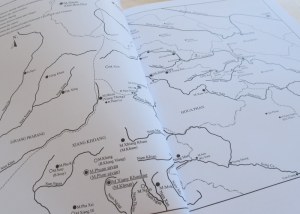 PHOTOS, ILLUSTRATIONS AND DIAGRAMS:
PHOTOS, ILLUSTRATIONS AND DIAGRAMS:
This book contains everything I expect from a good textile book:
- Maps to put the information into geographical context
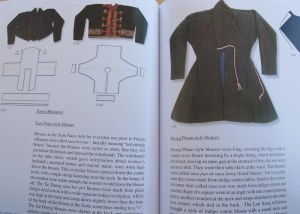 Loads of photographs. A few in black-and-white but mainly colour photographs which include detail shots of the textiles and designs, photos of the local people wearing, making and caring for the textiles, as well as lovely story pictures – photos of the community in which these textiles are made, loved and used.
Loads of photographs. A few in black-and-white but mainly colour photographs which include detail shots of the textiles and designs, photos of the local people wearing, making and caring for the textiles, as well as lovely story pictures – photos of the community in which these textiles are made, loved and used.- Diagrams and sketches showing the construction of some of the garments as well as some of the weaving equipment.
All in all, this book is comprehensively illustrated and contains valuable visual documentation of the Lao-Tai textiles.
CONTENT:
“My deepest thanks go to all the weavers, villagers and shamans who have patiently answered my enquiries, received me in their homes and guided me in my search for information.”
This opening sentence sets the tone of the whole book. Patricia shares her vast knowledge of the textiles, the history, and the people of this remote part of the world, with a tangible measure of respect, gratitude and humility. It is obvious that she not only loves her subject but that she has an affinity for the whole culture and lifestyle surrounding it.
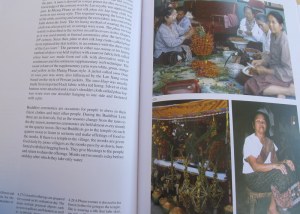 The book starts with the author’s acknowledgements and background notes on how her research was conducted, how she set the parameters for the book, and how the fact that she grew up in Asia and is fluent in the Lao language informed her research. Maps showing the current and historical ‘lay of the land’ further aids the reader to understand the subject matter.
The book starts with the author’s acknowledgements and background notes on how her research was conducted, how she set the parameters for the book, and how the fact that she grew up in Asia and is fluent in the Lao language informed her research. Maps showing the current and historical ‘lay of the land’ further aids the reader to understand the subject matter.
The first three chapters of the book look at the geographical and historical setting of the Lao-Tai culture as well as how these factors influenced the different classifications of textiles in the region.
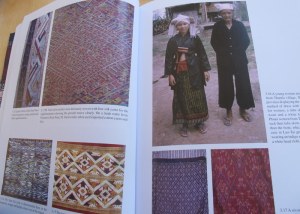 Chapter 4 gives background information about the Lao-Tai culture. The different gender roles, religious ceremonies, wedding and burial ceremonies, as well as the role of local food and architecture, can be seen to influence the different textile designs.
Chapter 4 gives background information about the Lao-Tai culture. The different gender roles, religious ceremonies, wedding and burial ceremonies, as well as the role of local food and architecture, can be seen to influence the different textile designs.
Chapter 5 to 7 give detail insights into the different garments worn by both men and women of the different clans. These chapters are beautifully illustrated with photos and diagrams.
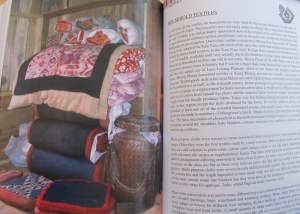 Both the Shamanic and Buddhist religions had a great influence in the design and use of textiles and Chapter 8 goes into great detail describing and illustrating each piece of textile used during religious ceremonies.
Both the Shamanic and Buddhist religions had a great influence in the design and use of textiles and Chapter 8 goes into great detail describing and illustrating each piece of textile used during religious ceremonies.
Household textiles holds a special appeal for me and Chapter 9’s descriptions of the pillows, blankets, curtains and other household items used by the Lao-Tai people, must be my favourite part of the book.
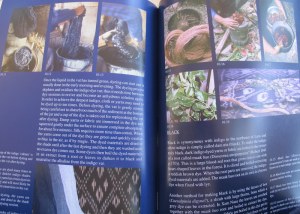 Chapter 10 is all about technique, showing detailed photos of the dyeing and weaving processes used by the artisans. It also shows how both silk and cotton are cultivated and prepared for dyeing and weaving. I love how the background colour of these pages add to the lush feel of the natural dyes.
Chapter 10 is all about technique, showing detailed photos of the dyeing and weaving processes used by the artisans. It also shows how both silk and cotton are cultivated and prepared for dyeing and weaving. I love how the background colour of these pages add to the lush feel of the natural dyes.
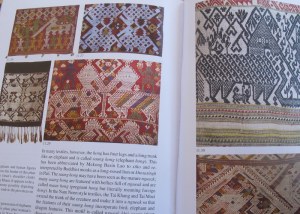 Chapter 11 describes the different symbols, designs and motifs depicted in the textiles. Again beautifully illustrated with detail photographs.
Chapter 11 describes the different symbols, designs and motifs depicted in the textiles. Again beautifully illustrated with detail photographs.
The book concludes with three Appendixes explaining the intricacies of the Lao-Tai languages. Essential information in understanding the names and descriptions of the different textiles.
CONCLUSION:
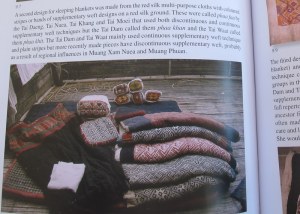 This is a beautiful book with loads of photos. It shows the textiles from a technical point of view as well as a cultural point of view. It puts the textile in the context of its origin. The place, the people and the history. But that is not all. This is not just a look-book – it is a read-book. It is beautiful and you can keep it on your coffee table, but when you go to bed, take it with you and actually read it. It is rich in information and beautifully written. It is obvious that Patricia loves her subject matter. Both the textiles and the community form which it comes.
This is a beautiful book with loads of photos. It shows the textiles from a technical point of view as well as a cultural point of view. It puts the textile in the context of its origin. The place, the people and the history. But that is not all. This is not just a look-book – it is a read-book. It is beautiful and you can keep it on your coffee table, but when you go to bed, take it with you and actually read it. It is rich in information and beautifully written. It is obvious that Patricia loves her subject matter. Both the textiles and the community form which it comes.
If you love textiles, books, travel, culture and beautiful pictures – this is your kind of book.
Order your copy today.
Read more about my visit to Studio Naenna

